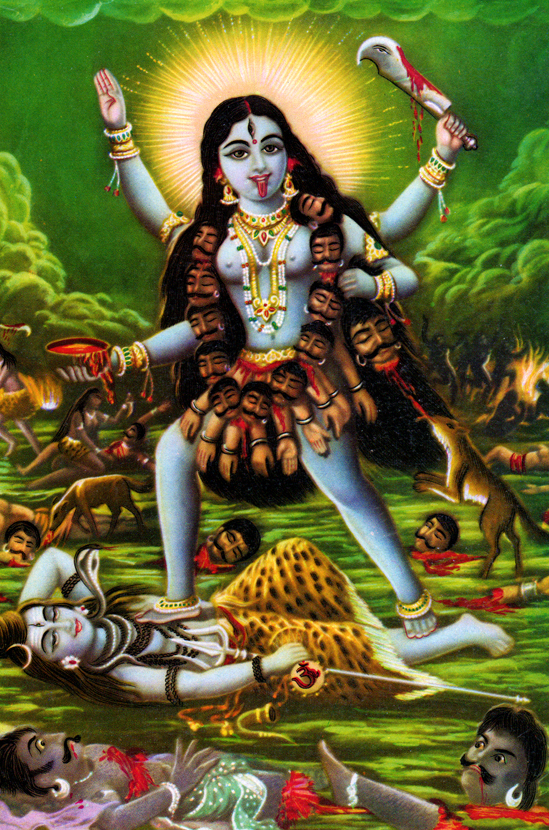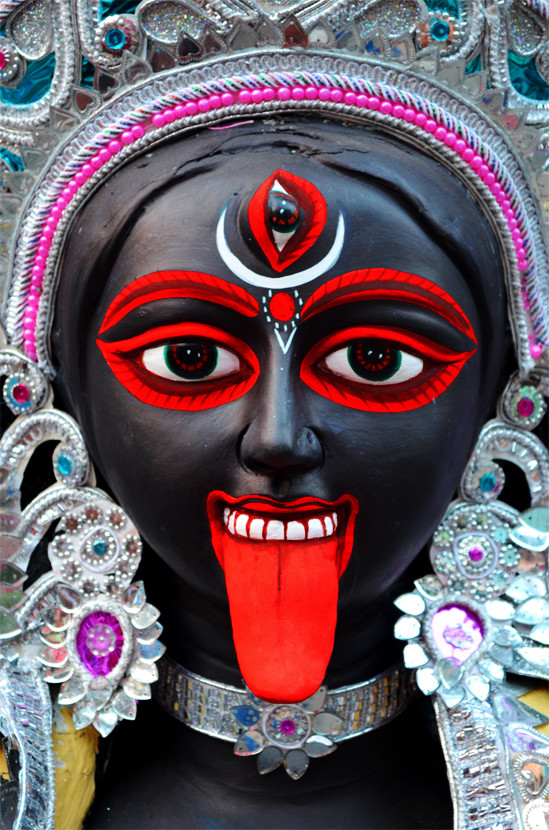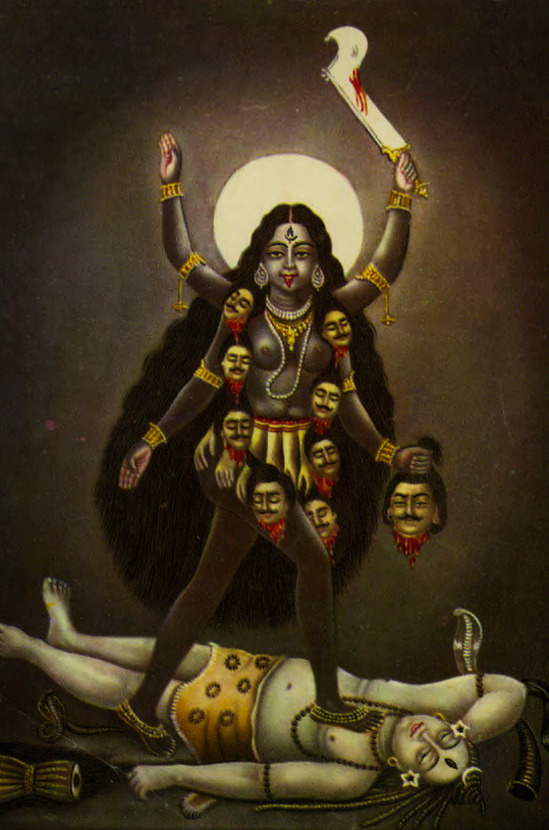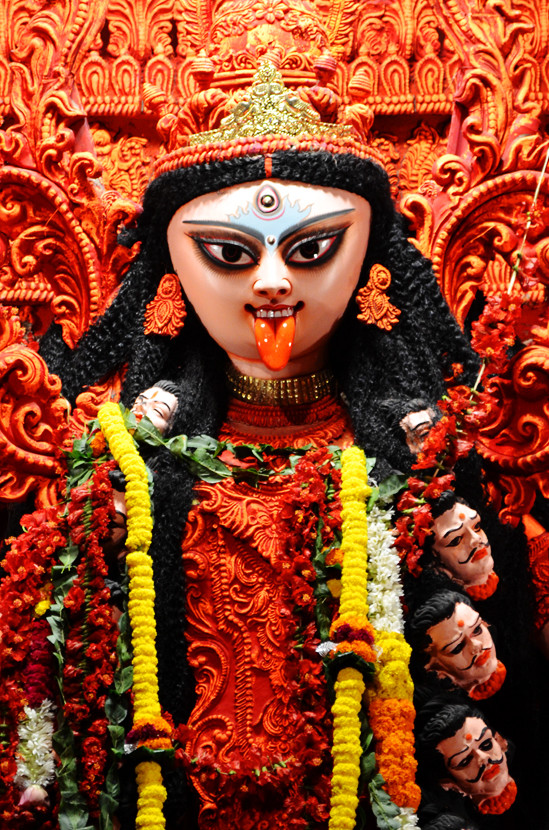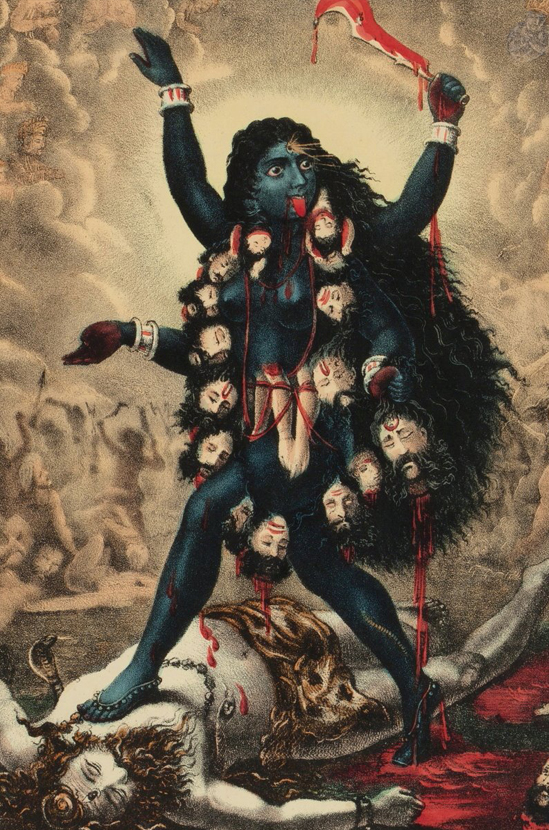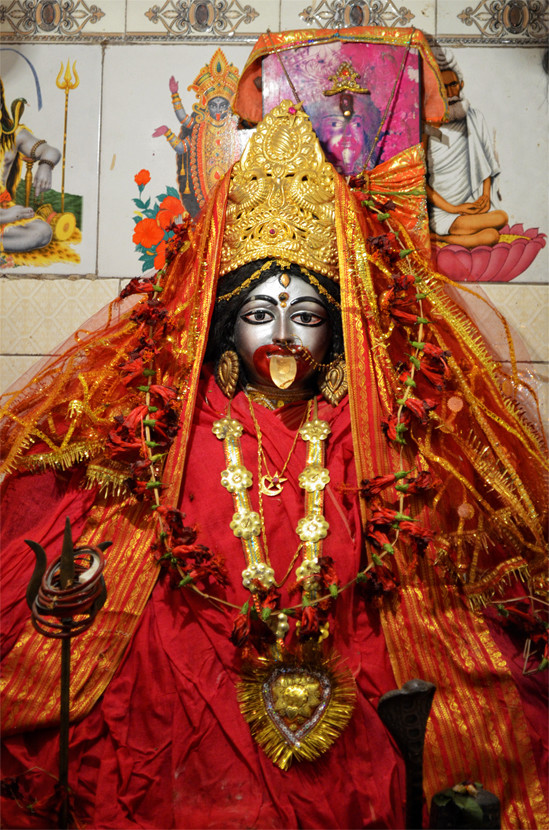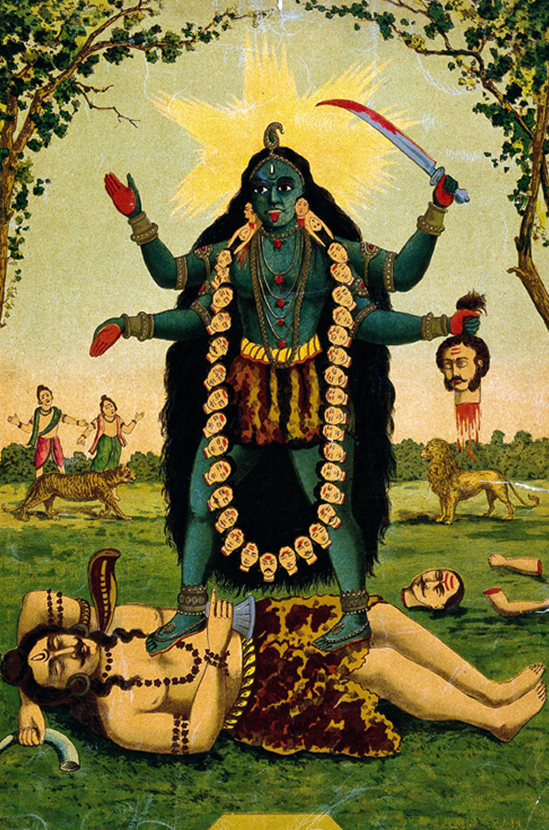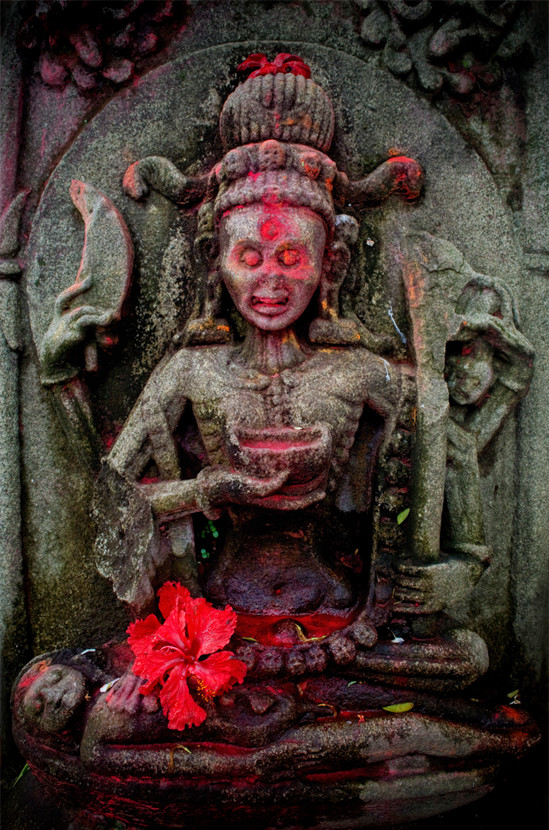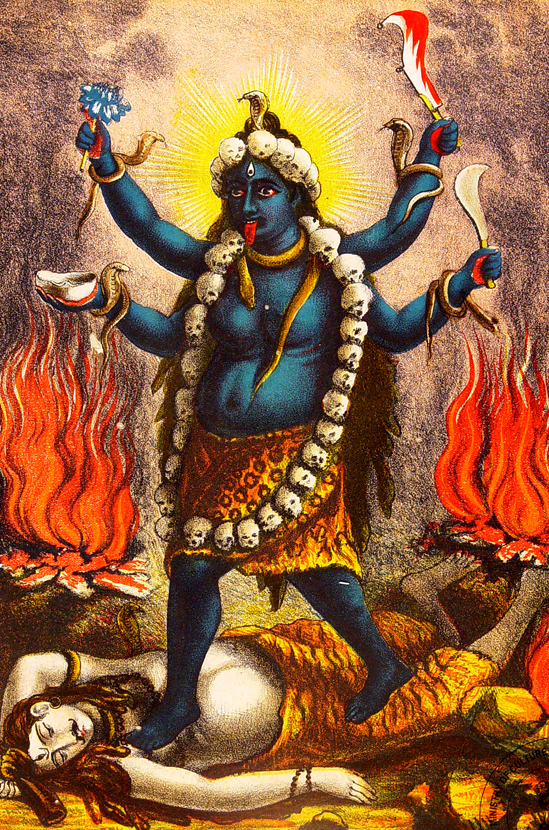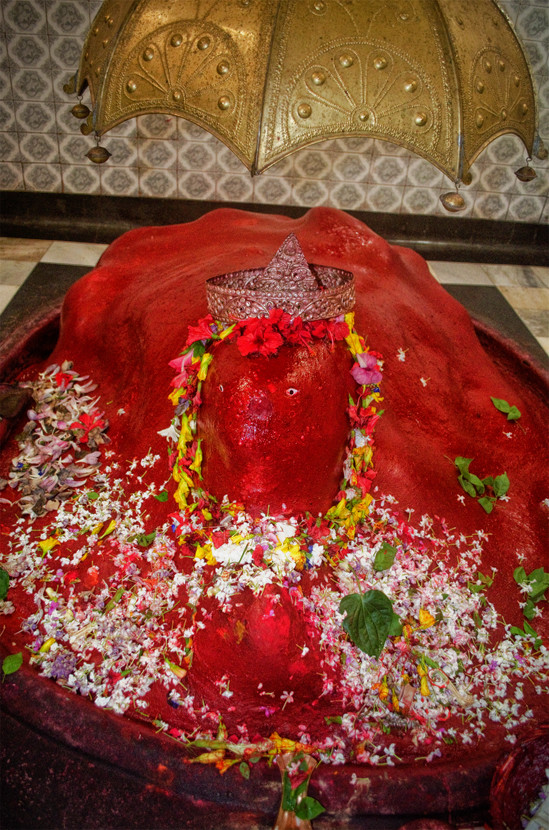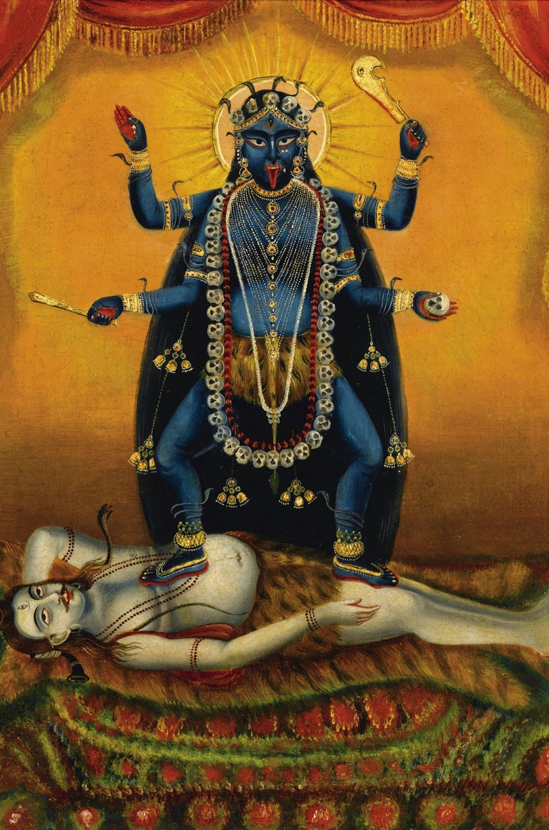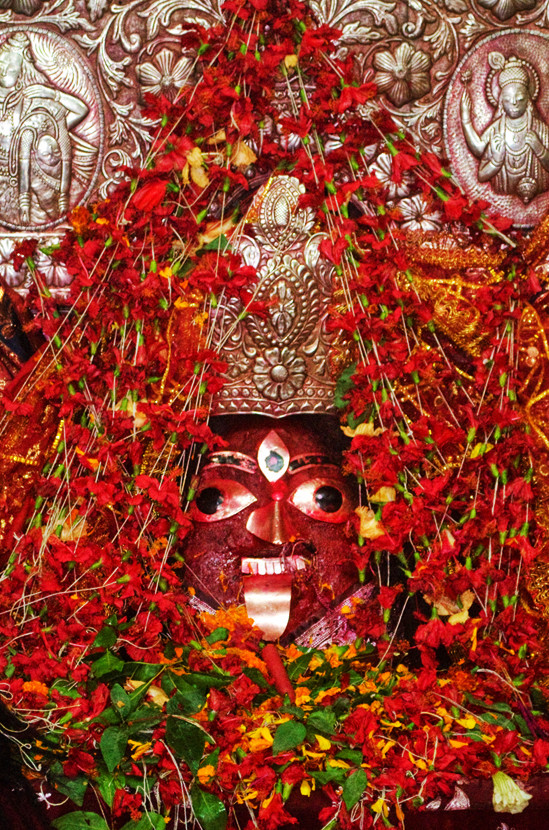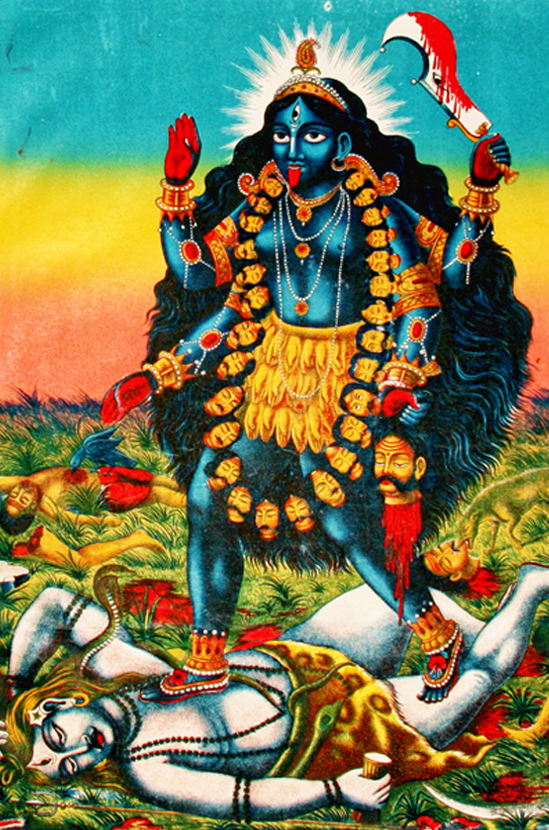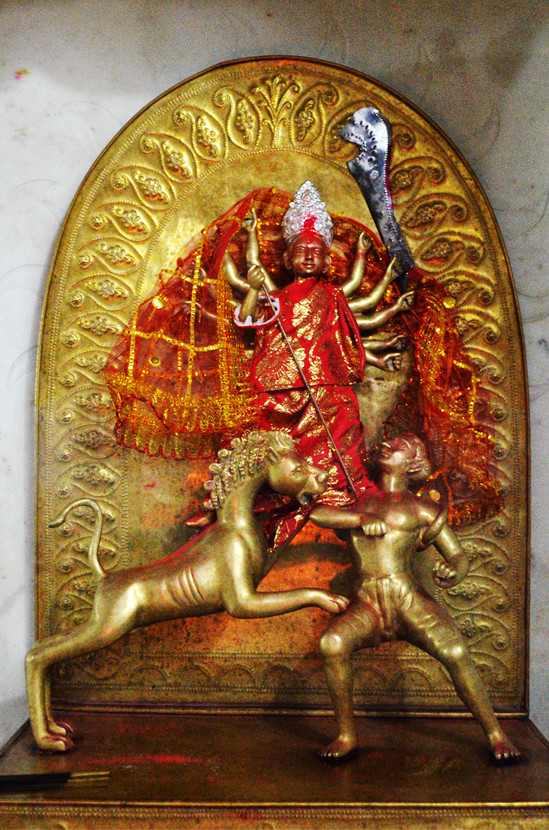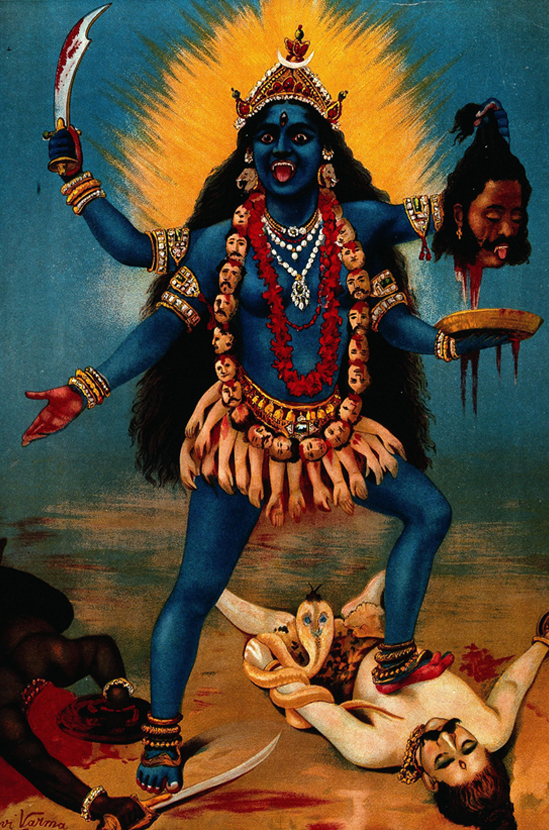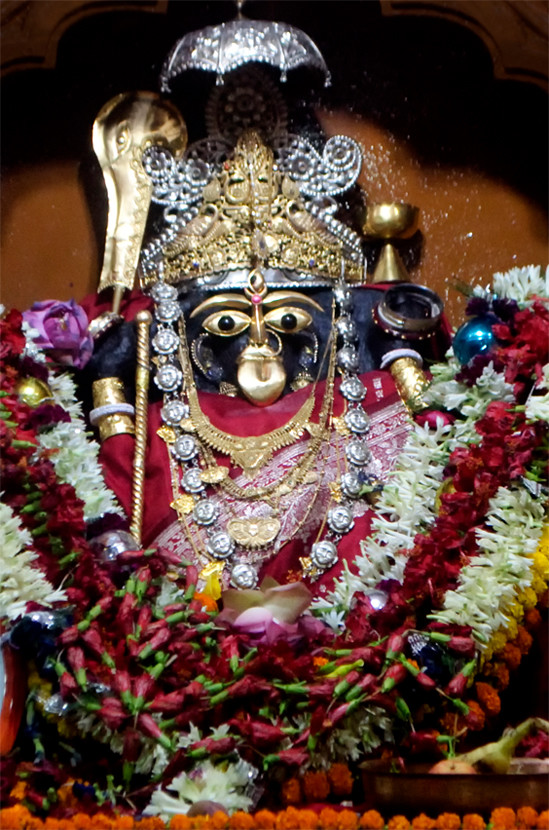Glossary
A
abhaya “Fear not.” The abhaya mudra is a common hand gesture seen in images of the divine signifying protection, benevolence, and the dispelling of fear. It is made with the right hand held at approximately shoulder level, elbow bent, palm facing outward with fingers raised and joined together.
Aghori Members of an ascetic Shaiva sect devoted to the particularly fierce manifestation of Shiva named Bhairav. Dwelling in cremation grounds, the Aghori are known for their bizarre behavior and transgressive rituals involving the consumption of intoxicants and cannibalism. Despite their fearsome reputation, the Aghori are accorded respect for the spiritual merits acquired through their extreme asceticism and sadhana.
ashtadhatu An alloy made from eight symbolic metals: gold, silver, copper, zinc, lead, tin, iron, and mercury.
avatar “Manifestation” An incarnation of the divine. Although the concept of avatar is most often associated with Vishnu (the ten avatars), other deities are said to descend and take corporeal form. Thus exalted saintly figures such as Dattatreya, Ramakrishna, and Chaitanya are also considered avatars.
B
baksheesh Money which is given for charitable purposes, as a form of tipping, or in the act of bribery.
Bangla
1. The colloquial name for the native language spoken in the north-eastern region of Bengal, Bengali.
2. A high proof country spirit (deshi mod), distilled through the fermentation of rice. It is somewhat risky to consume as an inherent lack of quality control in the production of moonshine can render it poisonous. Numerous cases of blindness and even death have been reported as a result of the thriving illicit Bangla trade. State-regulated Bangla is available and the strict quality-control standards make it relatively safe to drink. However, due to the counterfeiting of official government labels by various bootlegging syndicates, consumption of Bangla is contraindicated.
Baul Bengali folk minstrels. Specifically, Bauls are members of a mystical sect claiming descent from Nityananda. As itinerant musicians, members of the Baul cult seek ecstatic union with the divine through song and dance. The Bauls are a syncretic sect who have continuously synthesized esoteric practices culled from a variety of belief systems such as Tantra, Sufism, and Buddhism. This mercurial spiritual approach is also suggested by their style of dress which is typically a mixture of vestments and accessories appropriated from diverse spiritual traditions. While Baul clothing is typically bright orange, they are often seen wearing a guduri which is a motley patchwork vest, symbolic of their philosophy of human unity and categorical rejection of caste.
bhakta Devotee of a specific deity; a practitioner of bhakti yoga. A bhakta can venerate any embodiment of the divine be it a god, saint, or avatar and thus be considered a Kali bhakta, Krishna bhakta, Ramakrishna bhakta and so forth.
bhakti The path of loving devotion and one of the three types of yoga delineated by Lord Krishna in the Bhagavad Gita. Bhakti yoga is the path of loving devotion where a devotee dedicates themselves to chiefly revering one particular manifestation of the divine as supreme. Forms of devotion can include singing devotional songs (bhakti giti), temple pilgrimage, mantra japa, and offering pujas. The most-beloved deity of a bhakta is referred to as their ishta-deva (masculine), or ishta-devi (feminine).
bhru moddo Translates as “eyebrow middle,” referring to the portion of flesh between the eyebrows, This area of the body is often ornamented with a crescent moon in anthropomorphic representations of the divine feminine.
bidi Cigarettes which are hand rolled using tobacco leaf instead of paper.
boli Sacrifice where a goat is ritually offered to a goddess and decapitated. Afterward, the animal is butchered and its meat is consumed as prasad.
Brahmin Member of the priestly caste, considered the highest rank in the traditional four-fold scheme (varna). Most Brahmins will wear the yajnopivatam, or sacred thread which is conferred upon them during a coming of age initiation ceremony.
C
chandala A Sanskrit term denoting people who are considered outcaste or untouchable and traditionally relegated with jobs which such jobs as cleaning sewers, or disposing of corpses. Today the word chandala is used as a pejorative referring to people who are generally despised.
chillam Cylindrical pipe used for smoking ganja . A chillam can be made from any number of materials such as clay, stone, or wood. Smoking ganja from a chillam is a practice associated with sadhus who are part of the Shaiva sect.
D
darshan Blessing through seeing a manifestation of God. Darshan can be attained by seeing a sacred murti or holy person, as well as through the direct visionary experience of a deity.
dhak Large barrel-shaped drums played with sticks.
Dom Untouchable caste and its members who have traditionally been relegated with the task of disposing human corpses.
duggi Small kettle drum made from clay or metal with a goat skin head that is used in folk music. A duggi is often worn over the shoulder of a musician and is played with one hand, providing rhythmic accompaniment for the droning sound of the ektara.
E
ektara One-string musical instrument that provides both a drone and rhythmic accompaniment to folk music. The ektara is usually made using a dried gourd with an animal skin stretched over as a resonator and a neck of split bamboo cane. Its characteristic sound is generated by squeezing the neck while plucking the string which modulates the pitch.
F
G
gaan “Song.” The word gaan is Bengali and cognate with other commonly used terms for music such as such as giti and sangeet. Specifically, gaan refers to a particular style such as Baul Gaan, Shyama Gaan (songs dedicated to Kali), or Nandini Gaan (the music of snake charmers).
ganja Sanskrit for “cannabis.” Ganja consumption is strongly associated with the god Shiva. In India, marijuana is typically prepared in a number of ways: smoked by itself, mixed with tobacco, or as a form of hashish called charas. Ganja is also beaten into a paste called bhang, which can be eaten or mixed with curd and blended into a potent beverage known as a bhang lassi.
garbhagriha “Womb chamber.” The Sanskrit word sanctum sanctorum; the holiest place in a Hindu temple where the main murti, divine image, is installed.
ghat Steps leading down to a body of water which is usually a sacred river, but can refer to the steps of a natural or man-made pond.
ghungur Ankle bells worn in the performance of classical dance and also used by folk musicians such as the Baul.
giti “Song.” See gaan.
H
I
ishta “Cherished.” A particular manifestation of the divine that is most-beloved of a devotee (bhakta) and through which they commune with the supreme. Ishta-devi refers to a female goddess, while ishta-deva is used for a male god.
J
japa Practice of regular repetition of mantra, or divine name. Japa is often performed mala and can be chanted out loud, sung, or mentally recited. The practice of mantra japa is considered an efficacious meditational practice facilitating one-pointed concentration on a spiritual aim.
K
kartala Pair of small metal hand cymbals used to provide rhythmic accompaniment and keep time in musical performances or group chanting.
khadga Ritual decapitation sword used in the sacrificial rite of boli. The khadga is the preferred weapon of Kali and other powerful goddesses.
khamak Common name for a type of plucked drum used in folk music. It consists of a small wooden drum with an animal skin stretched over attached by a string to a much smaller drum. The larger drum is held under held under the arm and the string is pulled tight wit the smaller drum and struck with a plectrum. Increasing and decreasing the tension modulates the pitch.
khol Folk drum which has a large head on one side and much smaller head on the other allowing it to produce both deep bass and a high treble sounds.
kumkum Brightly-colored pigment powder used to mark sacred images. At Hindu temples, kumkum which has been offered to the deity is applied to the forehead of visiting devotees, marking the location of their third eye chakra, as a form of prasad. In West Bengal, it is traditional for married women to wear kumkum along the part of their hair.
kund A water tank that is part of a temple complex which is entered into by descending steps.
L
lingam “Sign.” A sacred symbol of Shiva representing male creative energy; the phallus. Representations of the lingam vary with a common form being that of a Narmada River stone supported in a pedestal called the yoni. Naturally occurring lingam shapes are also venerated such as the famous ice lingam of Amarnath.
M
mala “Garland.” typically consisting of 108 beads which is used to count rounds of mantra repetition in a spiritual practice known as japa. Malas are made from a wide range of materials including bone, seeds, wood.
mantra A sacred syllable, word, or grouping of words believed to have mystical power. Mantras are written upon or carved into objects to bless as well as repeatedly chanted with a mala in the spiritual practice known as japa. Mantras are also utilized with yantras in the ritual practices of tantra.
moksha “Liberation.” In HIndu dharma, moksha is the final stage of spiritual evolution when the soul is released from the bondage and suffering of reincarnation.
mudra “Seal” or “gesture.” In Hindu iconography, mudras are symbolic hand gestures displayed by gods and saints which convey specific meanings. Mudras are also employed in yoga practices where they are combined with such things as asana and breath control to enhance meditation.
murti “Embodiment.” A sacred image facilitating communion with the divine. A murti can be made from a lasting material such as stone, wood, or metal and installed as the focal point of temple worship, or it can be crafted from terracotta and used over the course of a puja festival after which it is immersed in water and destroyed.
N
natmandir Roofed platform directly adjacent to the main mandir where devotees can congregate and receive darshan.
O
P
pandal Temporary structure erected to house the murti of a deity for the duration of a puja festival.
pukur A natural or man-made pond.
prasad Substance which has been offered to a deity or holy person and considered blessed. Prasad can take the form of objects, such as flowers, or food which is then consumed. Intoxicants can also be transmuted into prasad with marijuana and alcohol often being referred to as Shiva and Kali prasad respectively.
puja “Adoration” or worship.” A puja can take many forms such as large public festivals like Durga Puja, formalized temple ritual, or the offering of incense and sweets before an icon in the home.
Q
R
rudraksha “Rudra’s eyes.” Name for the evergreen tree E. ganitrus, its seeds, and the prayer beads made from those seeds. Beads of rudraksha are often threaded into rings called malas which are used for counting repetitions of mantras. Rudraksha malas are commonly associated with people following the traditions of Shiva and Shakti.
rup “Form.” The physical manifestation of a deity, usually referring to a natural formation such as a stone.
S
sadhana Goal-oriented disciplines motivated by spiritual or ritual intent. As sadhana involves concentration and self-sacrifice, this term applies to a diverse range of methodologies such as the austerities of yoga or the practicing of a musical instrument.
sadhu “Holy man.” Sadhu broadly denotes people who follow a spiritual path of renunciation and practice sadhana. Sadhus can follow the traditions associated with one of the major sects such as Shaiva, Vaishnava, and Shakta. The feminine form of the word sadhu is sadhvi and applies to female renunciates.
sadhvi Female sadhu. See sadhu.
sangeet “Song.” Refers to all styles of music from classical to folk. See gaan.
Shakti, shakti “Power” or “force.” The Cosmic Mother and agent of change who is the supreme being in the major Hindu branch called Shakta. In mundane usage, shakti is the word used for electrical power, or any kind of power in general.
shehnai Double reed wind instrument, similar to the oboe. The body of the shehnai is made from wood with a brass bell attached at the end. Since the sound it produces is considered particularly auspicious, the shehnai is often played during weddings, ceremonial processions, and at temple functions.
shikhara “Mountain peak.” A term used in Hindu temple architecture which refers to the rising tower above the sanctum sanctorum.
Shyama Sangeet “Kali songs.” A form of Bengali devotional music dedicated to the goddess Shyama which is another name for Kali.
sindoor See kumkum.
smashana “Cremation ground.” Traditionally, the smashana is an open area demarcated for the burning and burial of human corpses. In modern cities, a smashana can be the location of a crematorium.
T
tantra Name used for a spectrum of spiritual techniques and rituals as well as the scriptures delineating these practices. In tantra, the dichotomy of spiritual versus physical is eliminated and divinity is viewed as imminent and accessible through the manifest world. Tantrik practices are generally divided into two major categories: those of the right hand, dakshinachara and those of the left hand, vamachara. Left hand Tantriks may incorporate so-called “forbidden elements” like intoxicants, sexual intercourse, and eating meat into their rituals while right hand tantriks will avoid such things altogether or interpret them as symbolic.
Tantrik Practitioner of tantra, the art of magic. The spiritual path of a Tantrik is characterized by worship and occult practices focused primarily on various manifestations of the Mother Goddess. They are easily recognizable by their ritual vestments which are typically red, the color symbolic of Shakti.
tilak Forehead marking applied during puja, or worn as an indicator of sect. The typical tilak of Shaivas is three horizontal stripes, Viashnavs a U shaped fork, and Shaktas is a red vertical stripe.
trishula “Trident.” The characteristic weapon of Shiva which is carried by many Shaiva sadhus. The trishula is not merely a weapon, but a symbol for the powers of creation, preservation, and transformation as well as the spinal column and three major energy currents of Hindu esoteric anatomy.
U
V
varada “Favorable.” The varada mudra signifies the giving of boons as charity, compassion, and blessings. It is typically paired with the abhaya mudra in which case varada will be made with the left hand. However, if the figure is four-armed varada is often made with the lower right hand. Varada mudra is made with the arm lowered and palm facing upward with fingers raised or slightly bent.
W
X
Y
yantra “Instrument” or “machine.” Name for mystic diagrams which express unified patterns of energy in geometric form. Yantras can embody the power of a particular deity which otherwise might be expressed as an anthropomorphic representation or through sound as a mantra.
yoga “Yoke” or “to join.” A spiritual discipline aimed at achieving union with the divine; one of the six schools of traditional Hindu philosophy. Although yoga has become a popular word in the western world, it is usually practiced as a modified and stripped-down form of hatha yoga focused primarily on stretching and postures. There are in fact many types of yoga with karma yoga (action), jnana yoga (knowledge), and bhakti yoga (loving devotion) being among the most widely known.
yoni “Vagina.” Yoni is the exalted form of the female sexual organ and a sacred symbol of Shakti, the divine feminine power. The yoni is represented in its most basic geometric form as a descending equilateral triangle. Three-dimensional, stylized yonis are used as receptacles in which to hold a lingam stone symbolic of Shiva.
Z

